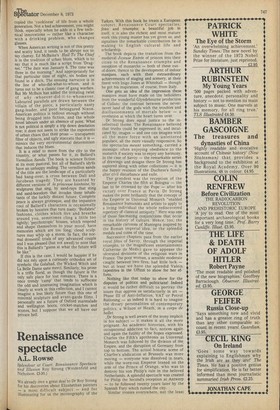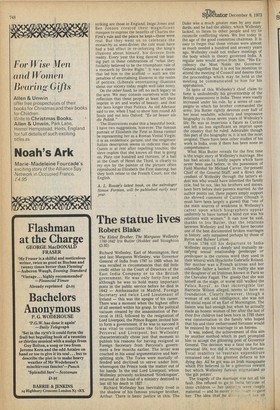Renaissance spectacle
A.L. Rowse
Splendour at Court. Renaissance Spectacle and Illusion Roy Strong (Weidenfeld and Nicholson. 0.95.)
We already owe a great deal to Dr Roy Strong for his discoveries about Elizabethan painters — a most difficult subject — and for Illuminating for us the inconography of the
Tudors. With this book he treats a European subject, Renaissance Court spectacles, fetes and triumphs; a beautiful job in itself, it is also the richest and most mature work this young master has yet given us, and signalises the remarkable contribution he is making to English cultural life and scholarship.
The book depicts the transition from the medieval Joyeuse Entrée of princes into their cities to the Renaissance triumphs and reception of monarchs — both of these outof-doors; thence to the development of indoor masques, each with their extraordinary achievements of staging and scenery, at their finest with 'nig° Jones at Whitehall — though he got his inspiration, of course, from Italy.
One gets an idea of the impression these masques must have made on the beholders from the wonderful Glyndebourne production of Calisto: the contrast between the nevernever land of the gods with the troubles and disillusionments of mortals below — a revelation at which the heart turns over.
Dr Strong does equal justice to the intellectual theme. The Renaissance believed that truths could be expressed in, and inculcated by. images — and one can imagine with all the more force with an unlettered populace, all the more visually responsive. So the spectacles meant something, carried a message: often enjoying obedience to the monarch if society was to enjoy any harmony. In the case of Savoy — the remarkable series of drawings and designs there Dr Strong has explored along with other collections — it is the happy reunion of the Duchess's family after civil disturbance and exile.
The grandest was the reception of the Emperor Charles the fifth at Bologna — the last to be crowned by the Pope — after his victory over France at Pavia. Dr Strong makes the point brilliantly that the concept of the Emperor as Universal Monarch "enabled Renaissance humanists and artists to apply to a living individual the whole rediscovered repertory of classical antiquity." Here was one of those fascinating conjunctions that occur in the history of culture. Hence, too, the remarkable cartoons of Mantegna inspired by the Roman imperial idea, or the splendid medals and coins of the time.
Successive chapters pass from the earlier royal fetes of Savoy, through the imperial triumphs, to the magnificent entertainments Catherine de Medici gave to appease the ulcerated divisions of the religious wars in France. The poor woman, a sensible moderate caught between two fires, had little luck, — but at least we have the splendid Valois . tapestries in the Uffizzi to show for her efforts.
Nothing like that today to show for the disputes of politics and politicians! Indeed it would be rather difficult to portray the issues that oppress us satisfactorily in art — Phase III of Anti-Inflation, VAT or Petrol • Rationing — as indeed it is hard to imagine the dreary personalities of contemporary politics, a Wilson or Heath, in a corps de ballet.
,Dr Strong is well aware of the irony implicit in his subject — it makes it all the more poignant. An academic historian, with his occupational addiction to fact, notices again and again the futility of the hopes expressed. Charles the. Fifth's apotheosis as Universal Monarch was followed by the division of the Empire, and the disruption of Germany from top to bottom. The actual historic scene of Charles's abdication at Brussels was more moving — everyone was dissolved in tears, while the worn-out Emperor leaned on the arm of the Prince of Orange, who was to destroy his son Philip's rule in the beloved Netherlands. A splendid spectacle was created for Philip the Second's reception at Antwerp — to be followed twenty years later by the Spanish Fury which ruined the city.
Similar ironies everywhere, not the least
striking are those in England. Inigo Jones and Ben Jonson created their magnificent masques to express the benefits of Charles the First's rule and the peace he kept—these were real. But they went on to celebrate the monarchy as semi-divine; the cult must have had a bad effect in re-inforcing the king's illusions about himself, his divorce from reality. Every year the king danced the leading part in these celebrations of "what they foolishly believed to be the triumphant rule of a monarch by Divine Right." It was a dance that led him to the scaffold — such are the penalties of entertaining illusions in the realm of politics. (Liberals entertaining illusions about our society today might well take note).
On the other hand, he left no such legacy in the arts. We may console ourselves with the reflection that these people at least left their imprint in art and works of beauty, and that Art lasts longer than Politics. As old Adenaur said to me, when I had to show him round All Souls and out into Oxford: "Es ist besser als die Politik."
The illustrations make this a beautiful book; I have two suggestions, however. The famous portrait of Elizabeth the First at Siena cannot be representing her as a Roman Vestal Virgin: it is an emblematic picture, and the enigmatic Italian description seems to indicate that the Queen is at rest after repelling trouble; the sieve implies that she knows all that is going on. Plate one hundred and thirteen, of a ball at the Court of Henri the Third, is clearly to my eye by the painter of the picture often reproduced as Elizabeth the First dancing; but they both relate to the French Court, not the English.
A. L. Rowse's latest book, on the astrologer Simon Forman, will be published early next year.











































 Previous page
Previous page